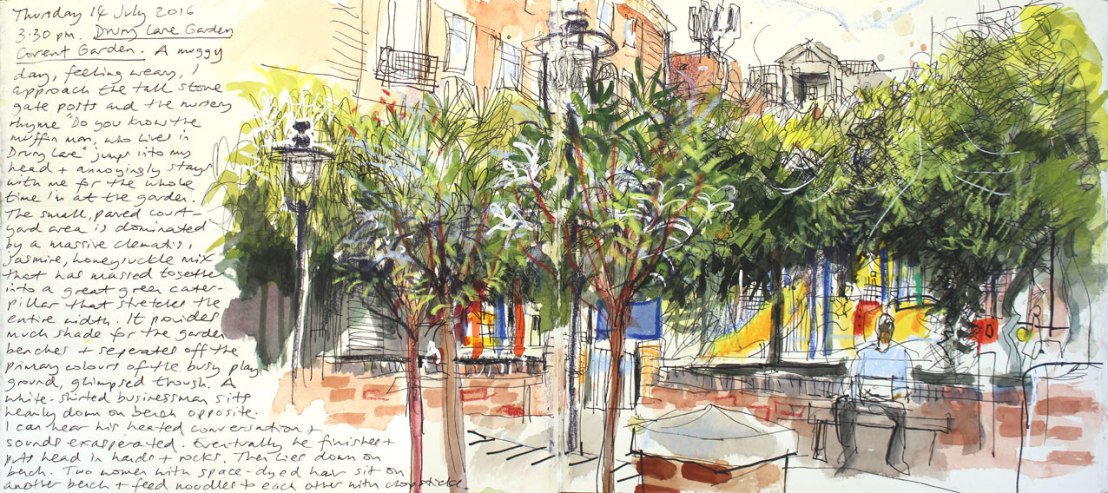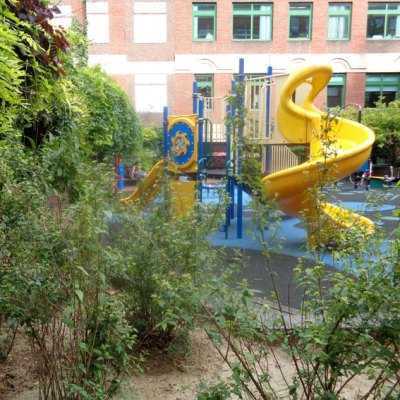 (Thursday 14 July 2016)
(Thursday 14 July 2016)
This little quarter- acre rectangle is wedged between office blocks, just round the corner from Theatre Royal Drury Lane (Charlie and the Chocolate Factory into its 3rd year!). And partly overlooked by the Fortune Theatre (The Woman in Black into its 25th year!). Today this area is a hub for family entertainment. In the early 1800s, however, this was the poorest part of London. Over- populated, rat infested and ramshackle, the entertainment it offered ranged from cock fighting and gambling slums to gin palaces and brothels!
On this muggy afternoon, as I approach the sturdy stone gateposts of the garden, a nursery rhyme bubbles up in my mind:
“Do you know the Muffin Man, The Muffin Man, the Muffin Man?…”
It stays with me, ominously, coming and going in my head for my whole visit, like one of those slightly sinister film soundtracks with children singing discordantly.
I walk up the steps into a small paved courtyard area. It’s dominated by a mass of clematis  and honeysuckle and jasmine that have amalgamated into an enormous green caterpillar, supported on a hidden pergola that carries it right across the garden. Today it provides some welcome shade while I sit on the brick edge of the raised bed, take a swig from my water bottle and look around.
and honeysuckle and jasmine that have amalgamated into an enormous green caterpillar, supported on a hidden pergola that carries it right across the garden. Today it provides some welcome shade while I sit on the brick edge of the raised bed, take a swig from my water bottle and look around.
The space in front of me is symmetrical: brick walls and pedestals, iron railings. Evergreen trees and shrubs soften the severity of the gothic chapel buildings on either flank. Access ramps curve up to this paved area. Turning around, I can see the very busy children’s playground, enclosed with low walls and gates. A bright yellow spirally climbing frame and slide; a pair of toddlers sit at the top, oblivious of the fidgety queue behind them. Further back, high netting protects a court for ball games. Empty at the moment.
“Do you know the Muffin Man, Who lives on Drury Lane?..”
As with St John’s Gardens last week, this space was also once a burial ground (for St Martin-in-the-Fields) until the mid 19th century. And it too suffered from overcrowding.
 All the worse for its location in the midst of such squalid deprivation. It had the vilest reputation and was perfect inspiration for Charles Dickens. In Bleak House, it was the burial site for Nemo, the opium addict. Dickens describes it as: “pestiferous and obscene, with houses looking on on every side, save where a reeking little tunnel of a court, a dark and miserable covered way, gives access to a burial ground where are heaps of dishonoured graves and stones, hemmed- in by filthy houses, on whose walls a thick humidity broke out like a disease”.
All the worse for its location in the midst of such squalid deprivation. It had the vilest reputation and was perfect inspiration for Charles Dickens. In Bleak House, it was the burial site for Nemo, the opium addict. Dickens describes it as: “pestiferous and obscene, with houses looking on on every side, save where a reeking little tunnel of a court, a dark and miserable covered way, gives access to a burial ground where are heaps of dishonoured graves and stones, hemmed- in by filthy houses, on whose walls a thick humidity broke out like a disease”.
The 1852 Burial Acts sought to put an end to horrific scenes like these. Larger cemeteries were being established away from the most populous parts of the city, such as Brompton Cemetery (see Sticks in the Smoke’ 6) to alleviate the pressure. This ground was closed for burials and grew wild for 20 years until, following the Open Spaces Act of 1877 (by which it became illegal to build on any ground that had been previously used for interments), it was the first burial ground to be made into a public garden in Westminster.
“Do you know the Muffin Man, The Muffin Man, the Muffin Man? Do you know the Muffin Man, Who lives on Drury Lane- o?…”
I perch with my back to the old mortuary, from where I can take in a good width of the  space, and start my drawing. Just visible above the clematis foliage is the bell tower of the Presbyterian Crown Court Church of Scotland. And next to that is the multi- spired cluster of mobile phone antennae on the roof of the Fortune Theatre. A white shirted business man strides up the steps in front of me, as though entering on stage. He’s holding a loud and exasperated phone conversation. It goes on as he slumps down onto a shaded bench opposite. The argument continues for a further 5 minutes until, with a heavy groan, he slams his phone down and hunches over with head in hands as if in prayer. He then sighs and turns and slowly lies down on the bench.
space, and start my drawing. Just visible above the clematis foliage is the bell tower of the Presbyterian Crown Court Church of Scotland. And next to that is the multi- spired cluster of mobile phone antennae on the roof of the Fortune Theatre. A white shirted business man strides up the steps in front of me, as though entering on stage. He’s holding a loud and exasperated phone conversation. It goes on as he slumps down onto a shaded bench opposite. The argument continues for a further 5 minutes until, with a heavy groan, he slams his phone down and hunches over with head in hands as if in prayer. He then sighs and turns and slowly lies down on the bench.
There are other players on this stage. A little boy discovers a new game: he gleefully launches his ride- on tractor down the access slope, to crash into his Mum’s legs, while she chats to a friend. He retrieves it and giggles back up the slope and repeats this a couple more times until, wearily, she hauls the wriggling bundle to her hip.
Two women with space dyed hair are feeding noodles to each other with chopsticks.
The harassed business man is now sitting and is tapping at his laptop. A child is waving coloured streamers in the playground behind him, which appear like whooshing blurs of pink and orange around his head.
“Yes I know the Muffin Man, The Muffin Man, the Muffin Man. Yes I know the Muffin Man Who lives on Drury Lane- o!..”
Two hundred years ago, muffins were dense, flattish wheat cakes: a cheap and filling foodstuff in poor areas such as Drury Lane. Muffin men, with their long aprons and trays of muffins on their heads, strode the streets, singing out their wares. It’s thought that this rhyme developed from these street cries. Other theories about it’s origins are more sinister, however. One popular belief is that the Muffin- Man was a child serial murderer, who used the little cakes to lure his victims to their gruesome fate, perhaps in the darkest corners of this graveyard. And this rhyme was about the hunt for this criminal (the last verse perhaps describing the crucial turning point in the long and tedious investigation!). But there’s no evidence to support this story.
Feeling hungry, I pack up my drawing things and leave in search of a bite to eat. Hmm, now what do I fancy?
In his ‘Sticks in the Smoke’ project, Nick Andrew has been regularly visiting, researching and drawing different publicly accessible parks or gardens in London since January 2016, exploring the theme of city green spaces from the perspective of a rural landscape painter. The first two sketchbooks will be published as a book in late 2018. www.nickandrew.co.uk . Nick is grateful to London Parks & Gardens Trust for their support www.londongardenstrust.org.
Drury Lane Garden, Covent Garden, London. WC2B 5TB
Google earth view here
Extraordinary, one doesn’t realise parks often have such a dark history. Wonderful sketch, full of life and colour and a contrast to the gruesome history. Think im put off muffins for life! XxX
LikeLike
Thankyou!! xxx
LikeLike